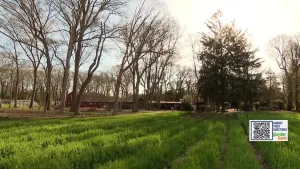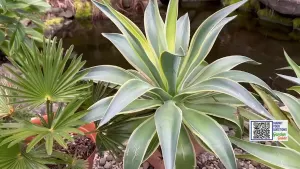Garden Guide: Imagine a rose that blooms all winter long... Alex introduces you to Camellias
There are several different species of camellia, but the most common are Camellia japonica and Sasanqua.
Share:
More Stories
2:10

Westport gardening experts share tips on what to plant during fluctuant spring weather
2ds ago1:57

Garden Guide: Fertilizer myths and tips
2ds ago1:33

Garden Guide: What is community-supported agriculture?
2ds ago1:36

Garden Guide: Do these garden chores in April for beautiful plants all season long
16ds ago3:34

Garden Guide: Learn how to compost
18ds ago2:34

Garden Guide: How to acclimate your plants back outdoors
23ds ago2:10

Westport gardening experts share tips on what to plant during fluctuant spring weather
2ds ago1:57

Garden Guide: Fertilizer myths and tips
2ds ago1:33

Garden Guide: What is community-supported agriculture?
2ds ago1:36

Garden Guide: Do these garden chores in April for beautiful plants all season long
16ds ago3:34

Garden Guide: Learn how to compost
18ds ago2:34

Garden Guide: How to acclimate your plants back outdoors
23ds agoImagine a rose with gorgeous leaves that blooms all winter long. It may seem too good to be true in our cold climate, but let me introduce you to Camellias. These subtropical shrubs will bring a burst of color and incredibly detailed flower shapes to the gardens long before most other shrubs. Although they used to be a rare sight in our area, warmer winters and new cold-hardy varieties are making camellias so much more common.
Types of camellias
There are several different species of camellia, but the most common are Camellia japonica and Sasanqua. Japonica have larger leaves and typically larger flowers that typically bloom in March-May in our climate. Sasanqua have small leaves and smaller flowers. They typically bloom from October through December. Each of these species can bloom periodically during mild spells in the middle of winter as well.
There are hundreds of different camellia varieties, but a few have been bred for cold tolerance and would make a better choice for our gardens.
Camellia Japonica “Spring’s Promise” is featured in the video above. It has small red blooms and an unusually early bloom time for climate - sometimes starting up in February during mild winters like this one.
Camellia sasanqua “Long Island Pink” was discovered on Long Island and is used in landscapes across the country for its cold tolerance.
The “April Series” camellias are one of the most commonly available for cold hardy camellias. They will bloom if winter temperatures remain above 0F, and can survive temperatures as cold as -5F.
How to take care of camellias
Camellia have broad evergreen leaves that are susceptible to sunburn in the summer and dehydration during winter months. Ideally, these plants should be kept in a warm spot of the yard - like a south or west exposure - in dappled sunlight. It is better for these plants to avoid direct morning sunlight during the wintertime. In general, Camellia sasanqua are more tolerant of sunlight than japonica camellias.
Donna Moramarco, the director of horticulture at Planting Fields Foundation says they treat their camellias like their rhododendrons. They like growing near pine trees in acidic soil. Planting Fields in Oyster Bay has several outdoor cold hardy camellia varieties in their collection and hundreds of more cold sensitive varieties in there greenhouse.
The Camellia House at Planting Fields is temperature controlled and houses 100 year old Camellia plants. They have the largest collection of Camellias under glass in the northeast. The blooms begin in mid-Autumn and last until early spring. Peak bloom is in February, usually around the time of the Annual Camellia festival.
The collection is open to the public for free 6 days a week. The Camellia house is closed for maintenance every Tuesday.
How big do camellias get?
Camellia shrubs can become quite large overtime. Some varieties have a columnar habit, but most grow wider than they do tall, so plan accordingly. Sasanquas tend to be smaller than Japonica and would work alongside azaleas. Japonica will eventually grow to the size of a small tree, similar to the common rhododendron.
Camellias set their flower buds in Autumn and should only be pruned in early or mid summer. If the flower buds are cut off, they will not bloom that year. These are very slow growing shrubs and do not typically need to be pruned.





